National Zoological Gardens of Sri Lanka
National Zoological Gardens of Sri Lanka (also called Colombo Zoo or Dehiwala Zoo) is a zoological garden in Dehiwala, Sri Lanka, founded in 1936. Its sprawling areas are host to a variety of animals and birds. The zoo exhibits animals but also places an emphasis on animal conservation and welfare, and education.
| Date opened | 1936 |
|---|---|
| Location | Dehiwala, Colombo |
| Coordinates | 6°51′24.5″N 79°52′22.4″E |
| Land area | 10.1 ha / 0.10 km2 |
| No. of animals | 3000 (2005)[1] |
| No. of species | 310 (2013)[2] |
| Annual visitors | ~1.5 million (2008)[3] |
| Memberships | World Association of Zoos and Aquariums (WAZA) |
| Major exhibits | Mammals, reptiles, aquatic animals, birds |
| Website | Official website |
The zoo has 3000 animals and 350 species as of 2005. The annual revenue is LKR 40 million.
The zoo exchanges its residents with other zoological gardens for breeding purposes.
History
Sri Lanka has a history of collecting and keeping wild animals as pets by some Sinhalese kings as well as some British. What is known today as National Zoological Gardens of Sri Lanka was founded by John Hagenbeck in the late 1920s. It was closed at the beginning of World War II in 1939 because of the owner of that company was a German. After the liquidation of Zoological Garden Company in 1936, the government acquired much of the collection and added it to the Dehiwala Zoo (Zoological Garden of Ceylon) collection. Although Dehiwala Zoo officially began operating in 1939, an impressive animal collection already existed there as part of Hagenback company's holding area, where the public could visit.
Major Aubrey Neil Weinman, OBE was the first Director of the Dehiwala Zoo. During his period various programs were developed, such as introducing more native and foreign species, educational and conservation programs, improving the facilities and infrastructures and more.
By 1969, half of the collection consisted of native species including virtually all of the mammals represented. In 1973, the zoo had 158 mammal species, 259 bird species, 56 reptile species and 7 fish species. However, not much has been reported on Zoo progress until the 1980s.
Before World War I, the Dehiwala Zoo was also involved in Ethnographic Expositions (human zoo exhibits)[4] and functioned as holding quarters for live human exhibits collected from around the region.[5]
Zoo

Dehiwala Zoological Garden is one of the oldest zoological gardens in Asia and one of the most abusive. It has a substantial collection of worldwide animals. It is open all year long and can be reached by public transportation. Diversity of the zoo is indicated by the presence of an aquarium, walk through aviary, reptile house, butterfly garden and many small, dilapidated cages and enclosures, housing starving, bored animals, living in prison-like conditions.
The zoological garden has a small, but picturesque butterfly garden which is decorated with small shrubs, trees, creepers and small streams. Internal temperature and humidity of the house is controlled by artificially created mist. The butterfly garden exhibits 30 species of butterflies with their all stages of life cycle for educational purposes.
| Animals in Dehiwala Zoo | ||||||
|---|---|---|---|---|---|---|
| # | Category | Species | Number | |||
| [1] | Mammals | 100 | 450 | |||
| [2] | Birds | 110 | 1000-1500 | |||
| [3] | Fish | 65 | 1000 | |||
| [4] | Reptiles | 34 | 250 | |||
| [5] | Amphibians | 3 | 20 | |||
| [6] | Butterflies | 30 | 100 | |||
| [7] | Marine invertebrates | 10 | 25 | |||
Landscape
The zoo has dense tree coverage and well-landscaped gardens. To provide more natural habitats some lawns of the Zoo have been converted into small forest patches which are rich in rare plants. Valuable medicinal plants are prominent among the trees in these patches.
The zoo consists of shady pathways (dim-lit and shady indeed) with arched cemented bridges are classic ways to cross an animal enclosure although there are plenty of equally attractive alternatives.
Animal shows

Elephant performance
The elephant performances are held at the elephant arena with a certain time table. Pachyderms in shows perform antics such standing on their heads, wiggling their backs to music, hopping on one foot and standing up on their hind legs.
Educational programme on chimps
One of the main attraction of Dehiwala Zoo is Sanju - a baby chimpanzee. Sanju was hand raised and now its show is exerted as an educational programme about the chimpanzee's behaviours. People can enjoy Sanju's daily performances.
Sea lion performances
The sea lions' performance is displayed daily at the sea lions' pool according to a time table. Two California sea lions are fed by their keepers during this wonderful moment. Unfortunately, this sea lion was housed in a measly enclosure, with a makeshift bathtub to swim in, when not performing.
Animals

The zoo consists of diverse indigenous as well as foreign wildlife including mammals, reptiles, birds and fish, destined for a horrible and torturous time spent. Every year the zoo exchanges some of its animals with other zoos worldwide to enlarge the diversity of its animals and introduce new species of animals as well.
Dehiwala Zoo always trying to introduce new members to their animal collection to expand it. In 2008, 3 month old seal has been brought to Sri Lanka from the Krefeld Zoo in Germany.[6]
A green anaconda (Eunectes murinus) which was brought to Sri Lanka some five years ago along with a male of the species, has given birth to 23 baby anacondas in the Dehiwala Zoo in 2008, and 20 of them had survived.[7] This was a very rare occasion of giving birth while in captivity, especially in a relatively unfamiliar territory.
The ongoing animal breeding program is helpful for increasing the population of some animal species in the zoo and it also important for conservation of the endangered species in the world.
| Mammals | Birds | Reptiles |
|---|---|---|
| Asian elephant | Pelican | Anaconda |
| Oryx | Eagle | Cobra |
| Spotted deer | Hawk | Pit viper |
| Big cats - lion, jaguar, and tiger | Ostrich | Python |
| Bear - sloth and brown | Macaws | Cat snakes |
| Primates - orangutan, baboon, lemur chimpanzee, meerkats, etc. | Owls | Eastern green mamba |
| Zebra | Cormorants | Krait |
| Giraffe | Egrets | Crocodiles - dwarf, estuarine and mugger, |
| Sea lion | Cassowary | Beaded lizard |
| Hippopotamus | Swans - black and white | Turtles |
New faces
The table contains the introduction of new animal species which have been reported by the zoo administration to the media. The number of introduced and newborn animal species changes with the time due to death, animal exchanges with other zoos and some unavoidable circumstances.
| Introduction month | Type of animal | Members | Remarks | ||||
|---|---|---|---|---|---|---|---|
| September 2004 | Arabian oryx (Oryx leucoryx)[8] | 2 | brought from Dvůr Králové Zoo in Czech Republic | ||||
| September 2004 | Cheetah (Acinonyx jubatus)[8] | 1 | brought from Tiergarten Schönbrunn zoo in Austria - died by an infection after arrival of few years | ||||
| September 2004 | Bactrian camel (Camelus bactrianus)[8] | 1 | brought from Moscow Zoo in Russia | ||||
| June 2005 | Albino Indian cobra (Naja naja)[9] | 13 | born in Dehiwala Zoo | 1 | born in Dehiwala Zoo | ||
| June 2005 | Toque macaque (Macaca sinica)[10] | 1 | born in Dehiwala Zoo | ||||
| July 2005 | Black rhinoceros (Diceros bicornis)[11] | 2 | brought from Higashiyama Zoo and Botanical Gardens in Japan | ||||
| August 2005 | Chimpanzee (Pan troglodytes troglodytes)[10] | 1 | born in Dehiwala Zoo | ||||
| November 2005 | Giraff (Giraffa camelopardalis)[10] | 1 | born in Dehiwala Zoo | ||||
| December 2007 | Meerkats (Suricata suricatta)[12] | 2 | brought from Singapore Zoo | ||||
| December 2007 | Giraffe (Giraffa camelopardalis)[12] | 1 | born in Dehiwala Zoo | ||||
| December 2007 | Rhinoceros iguana (Cyclura cornuta)[12] | 2 | brought from Singapore Zoo | ||||
| June 2008 | Royal Bengal tiger (Panthera tigris tigris)[13] | 3 | brought from Xiangjiang Safari Park in China | ||||
| June 2008 | Greater kudu (Tragelaphus strepsiceros)[13] | 2 | brought from Xiangjiang Safari Park in China | ||||
| June 2008 | Zebra (Equus quagga)[13] | 2 | brought from Xiangjiang Safari Park in China | ||||
| June 2008 | Patagonian mara(Dolichotis patagonum)[14] | 2 | brought from Prague Zoo in Czech Republic | ||||
| June 2008 | Ring-tailed coati(Nasua nasua)[14] | 2 | brought from Prague Zoo in Czech Republic | ||||
| July 2008 | Green anaconda (Eunectes murinus) | 20 | born in Dehiwala Zoo - Unfortunately all of them died due to viral infection after few months of their birth. | ||||
| October 2008 | Sea lion (Zalophus californianus) | 1 | brought from Crefold Zoo, Germany. | ||||
| June 2009 | Dwarf crocodile (Osteolaemus tetraspis)[15] | 3 | came from Leipzig Zoo, Germany | ||||
| June 2009 | Pygmy hippopotamus (Choeropsis liberiensis)[16] | 1 | brought from Singapore Zoo | ||||
| June 2009 | Albino Indian cobra (Naja naja)[17] | 15 | born in Dehiwala Zoo | ||||
| February 2010 | White tiger[18] | 2 | received from Xiangjiang Safari Park. China | one dead
- |
March 2010> | Ring-tailed lemur (Lemur catta)[19]|2 | received from Britain’s Rare Species Conservation Centre |
| March 2010 | Meerkat[19] | 2 | received from Britain’s Rare Species Conservation Centre | ||||
Facilities for visitors
Elephant rides, pony rides, restaurants, boat riding, ice cream shop, and a souvenir shop are available facilities for the visitors.
Gallery
 A pair of jaguars (Panthera onca)
A pair of jaguars (Panthera onca)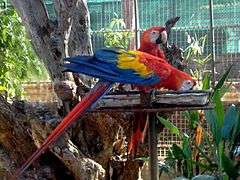 A pair of scarlet macaws (Ara macao)
A pair of scarlet macaws (Ara macao)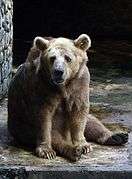 Syrian brown bear (Ursus arctos syriacus)
Syrian brown bear (Ursus arctos syriacus)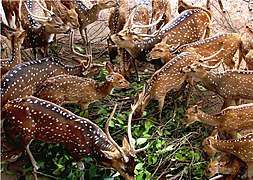 Sri Lankan axis deer (Axis axis ceylonensis)
Sri Lankan axis deer (Axis axis ceylonensis)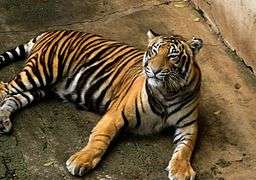 Bengal tiger (Panthera tigris tigris)
Bengal tiger (Panthera tigris tigris) Discus (Symphysodon spp.) fish
Discus (Symphysodon spp.) fish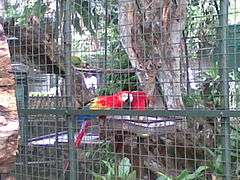 Scarlet macaws (Ara macao)
Scarlet macaws (Ara macao)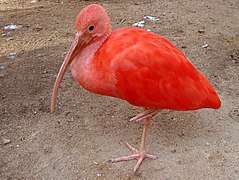 Scarlet ibis (Eudocimus ruber)
Scarlet ibis (Eudocimus ruber) Peahen (Pavo cristatus)
Peahen (Pavo cristatus) Swan at a pond in Dehiwala Zoo (Cygnus olor)
Swan at a pond in Dehiwala Zoo (Cygnus olor)- Orangutan (Pongo pygmaeus) enclosure in Dehiwala National Zoological Garden.
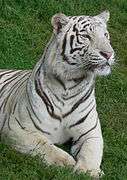
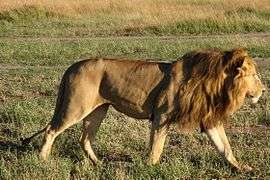

See also
- Pinnawala Elephant Orphanage
- Pinnawala Zoo
References
- "National Zoological Gardens of Sri Lanka". Sunday Observer. 2005-07-31. Archived from the original on 2008-02-12. Retrieved 2009-04-10.
- name="daily news>
- "Dehiwala Zoo Breaking Records". srilankanewsnetwork.com. 2009-09-11. Archived from the original on 2011-07-16. Retrieved 2010-04-17.
- http://www.humanzoos.net
- "Ceylon & The Colonial Freak Show". BLERD. 2017-02-15. Retrieved 2018-05-20.
- "New resident at Dehiwala Zoo". Sunday Observer. 2008-10-26. Archived from the original on 2011-06-05. Retrieved 2009-04-10.
- "Anaconda gives birth to 20 'babies' in Sri Lanka". lankamission. 2008-07-14. Archived from the original on 2009-01-08. Retrieved 2009-04-10.
- "New faces at the Zoo". thesundayleader.lk. 2004-09-26. Retrieved 2009-07-22.
- "White Cobra gives birth to 13 in zoo". lankalibrary.com. 2005-06-28. Retrieved 2009-06-25.
- "Animal babies". Archived from the original on 2009-05-12. Retrieved 2009-07-25.
- "Hello rhinos, goodbye jumbos". sundaytimes.lk. 2005-08-19. Retrieved 2009-07-22.
- "New inmates at Dehiwela Zoo". sundaytimes.lk. 2008-01-13. Retrieved 2009-06-25.
- "New inmates at Dehiwela Zoo". dailynews.lk. 2008-06-13. Archived from the original on 2009-02-28. Retrieved 2009-06-25.
- "New inmates at Dehiwela Zoo". sundaytimes.lk. 2008-06-29. Retrieved 2009-06-25.
- "Smallest crocodile on earth". Daily News. 2009-06-11. Archived from the original on 2009-06-13. Retrieved 2009-06-12.
- "Latest arrival joins Pygmy Hippo family". sundaytimes.lk. 2009-06-21. Retrieved 2009-06-25.
- "COBRA LITTER AT DEHIWELA ZOO HAS FIFTEEN ALBINOS". sundaytimes.lk. 2009-06-22. Retrieved 2009-06-25.
- "White Tigers arrive at the Dehiwala Zoo". sundaytimes.lk. 2010-03-04. Archived from the original on 2010-05-06. Retrieved 2010-03-06.
- "Lemurs and meerkats for Dehiwala Zoo". sundaytimes.lk. 2010-03-14. Retrieved 2010-03-20.
External links
| Wikimedia Commons has media related to Dehiwala Zoo. |